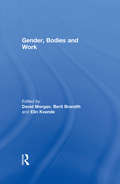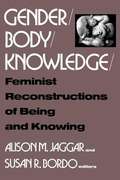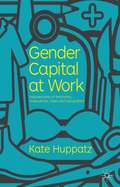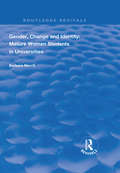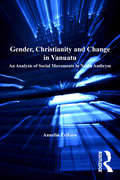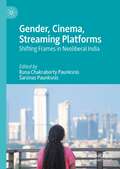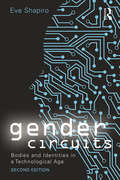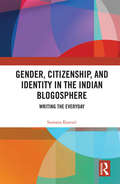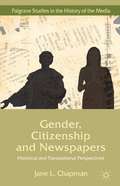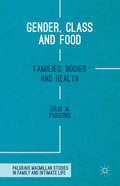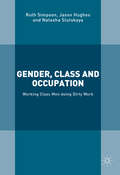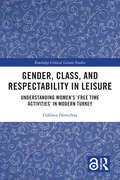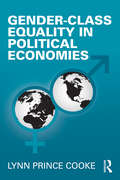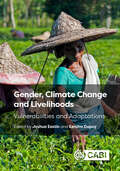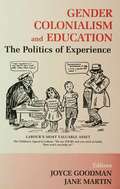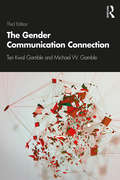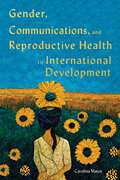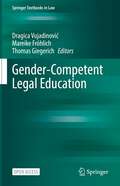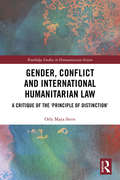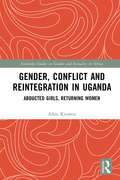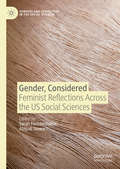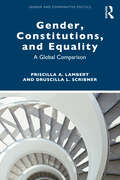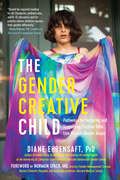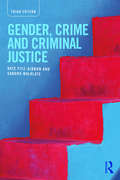- Table View
- List View
Gender, Bodies and Work
by Berit BrandthAll work is gendered and all work is embodied. Yet, in common with so many features of social life, these connections have remained largely unnoticed in most areas of social enquiry. All three topics - gender, bodies and work - have their own history and theoretical concerns and have recently showed signs of convergence. This volume recognizes this convergence and explores the inter-connections more specifically. The authors provide a set of questions which draw together themes already present in existing studies and which provide the basis for further analysis and theoretical elaboration. The chapters explore processes of embodiment and disembodiment within working settings and discuss the implications of these for the construction of gendered identities. Enhancing our knowledge of all three terms, Gender, Bodies and Work develops a perspective that has considerable potential both for assessing the past and exploring the future.
Gender / Body / Knowledge: Feminist Reconstructions of Being and Knowing
by Susan R. Bordo Alison M. JaggarThe essays in this interdisciplinary collection share the conviction that modern western paradigms of knowledge and reality are gender-biased.
Gender Capital at Work
by Kate HuppatzDrawing on interviews with nurses, social workers, exotic dancers and hairdressers, this book explores the processes involved in producing and reproducing gendered and classed workers and occupations.
Gender, Change and Identity: Mature Women Students in Universities (Routledge Revivals)
by Barbara MerrillFirst published in 1999, this volume centres on a case study which looks at the experiences of non-traditional adult women students in universities, from the perspective of the actors. The interaction of structure and agency and the significance of macro and micro levels in shaping the behaviour, attitudes and experiences of women adult students are examined by drawing on three perspectives: feminism, Marxism and interactionism. An underlying question is to what extent did studying change the way participants perceived themselves as women? It relates life histories to their student career as individuals and collectively as subcultural groups. It also breaks new ground by including a sample of male adult students in order to compare and clarify gender issues. It also uses macro and micro sociological theories as a tool for understanding the experiences of women at university and the relationship between their public and private lives. The book concludes that studying for a degree represented an active decision to take greater control, to break free from gender and class restraints, and to transform individual lives. The study aims to clarify and reassert the radical individual traditions within sociology, feminism and adult education.
Gender, Christianity and Change in Vanuatu: An Analysis of Social Movements in North Ambrym (Anthropology and Cultural History in Asia and the Indo-Pacific)
by Annelin EriksenFocusing on cultural change and the socio-political movements in the Pacific island nation of Vanuatu, this book uses both anthropological and historical analysis to examine the way the relationship between gender and Christianity has shaped processes of social change. Based on extensive research conducted over several decades, it is one of the few books available to focus on Vanuatu and on the impact of Christianity in Melanesia more generally - as well as on the significance of gender relations in understanding these developments. Providing a model for understanding and comparing processes of change in small-scale societies, this fascinating book will appeal to scholars and students interested in the ethnography of Melanesia and in issues related to contemporary cultural change and gender more generally.
Gender, Cinema, Streaming Platforms: Shifting Frames in Neoliberal India
by Runa Chakraborty Paunksnis Šarūnas PaunksnisThis book offers interdisciplinary examination of gender representations in cinema and SVOD (Subscription Video on Demand) platforms in India. This book will identify how the so-called feminist enunciations in twenty-first century film and SVOD content in India are marked by an ambiguous entanglement of feminist and postfeminist rhetoric. Set against the backdrop of two significant contemporary phenomena, namely neoliberalism and the digital revolution, this book considers how neoliberalism, aided by technological advancement, re-configured the process of media consumption in contemporary India and how representation of gender is fraught with multiple contesting trajectories. The book looks at two types of media—cinema and SVOD platforms, and explores the reasons for this transformation that has been emerging in India over the past two decades. Keeping in mind the complex paradoxes that such concomitant process of the contraries can invoke, the book invites myriad responses from the authors who view the shifting gender representations in postmillennial Hindi cinema and SVOD platforms from their specific ideological standpoints. The book includes a wide array of genres, from commercial Hindi films to SVOD content and documentary films, and aims to record the transformation facilitated by economic as well as technological revolutions in contemporary India across various media formats.
Gender Circuits: Bodies and Identities in a Technological Age (Sociology Re-Wired)
by Eve ShapiroThe new edition of Gender Circuits explores the impact of new technologies on the gendered lives of individuals through substantive sociological analysis and in-depth case studies. Examining the complex intersections between gender ideologies, social scripts, information and biomedical technologies, and embodied identities, this book explores whether and how new technologies are reshaping what it means to be a gendered person in contemporary society.
Gender, Citizenship, and Identity in the Indian Blogosphere: Writing the Everyday
by Sumana KasturiThis book examines the role of women bloggers in the Indian Blogosphere. It explores how women use new media technologies to create online spaces that share knowledge, raise awareness, and build communities. A unique work at the intersection of digital culture, feminist theory, and diaspora/transnationalism studies, this book brings to light layered and complex issues such as identity, gender performativity, presentation of self, migration, and citizenship. This volume will be useful for scholars and researchers of cultural studies, political studies, gender studies, women’s studies, sociology, diaspora studies, feminist theory, media and communication studies.
Gender, Citizenship and Newspapers
by Jane L. ChapmanThe gendered nature of the relationship between the press and emergence of cultural citizenship from the 1860s to the 1930s is explored through original data and insightful comparisons between India, Britain and France in this integrated approach to women's representation in newspapers, their role as news sources and their professional activity.
Gender, Class and Food: Families, Bodies and Health (Palgrave Macmillan Studies in Family and Intimate Life)
by Julie M. ParsonsEveryday foodways are a powerful means of drawing boundaries between social groups and defining who we are and where we belong. This book draws upon auto/biographical food narratives and emphasises the power of everyday foodways in maintaining and reinforcing social divisions along the lines of gender and class.
Gender, Class, and Freedom in Modern Political Theory
by Nancy J. HirschmannIn Gender, Class, and Freedom in Modern Political Theory, Nancy Hirschmann demonstrates not merely that modern theories of freedom are susceptible to gender and class analysis but that they must be analyzed in terms of gender and class in order to be understood at all. Through rigorous close readings of major and minor works of Hobbes, Locke, Rousseau, Kant, and Mill, Hirschmann establishes and examines the gender and class foundations of the modern understanding of freedom. Building on a social constructivist model of freedom that she developed in her award-winning book The Subject of Liberty: Toward a Feminist Theory of Freedom, she makes in her new book another original and important contribution to political and feminist theory. Despite the prominence of "state of nature" ideas in modern political theory, Hirschmann argues, theories of freedom actually advance a social constructivist understanding of humanity. By rereading "human nature" in light of this insight, Hirschmann uncovers theories of freedom that are both more historically accurate and more relevant to contemporary politics. Pigeonholing canonical theorists as proponents of either "positive" or "negative" liberty is historically inaccurate, she demonstrates, because theorists deploy both conceptions of freedom simultaneously throughout their work.
Gender, Class and Occupation
by Ruth Simpson Jason Hughes Natasha SlutskayaThisinsightful new study explores an emerging and growing interest in Sociology andOrganization Studies which concerns the meanings and experiences of 'dirty'work. Based on a unique study of male streetcleaners, refuse collectors, graffiti removers and butchers, and drawing onBourdieu as a theoretical frame, it presents an 'embodied' understanding of'dirty' work. Gender, Work and Occupationexplores new avenues of workplace studies, highlighting how materialconditions both support and constrain processes of occupation-based ideologicalconstructions. Using original field research, the authors put forward adifferent agenda in terms of how we think about dirty work, and how we canexplore and understand the 'lived experiences' of dirty workers.
Gender, Class, and Respectability in Leisure: Understanding Women’s ‘Free Time Activities’ in Modern Turkey (Routledge Critical Leisure Studies)
by Gökben DemirbaşThis book interrogates the role of gender and class in shaping women’s everyday leisure practices. Drawing on empirical research in urban Turkey, the book explores how leisure is perceived and practised by women within their communities.The book examines the relationship of women’s leisure to their labour, women’s access to and uses of public leisure spaces, and the dynamics of their everyday sociability within their neighbourhoods. It is the first book to apply Skegg’s concept of ‘respectability’ – socially recognised judgments and standards which label the ‘right’ practices, that hold morality and power in a given context – as a theoretical tool with which to understand leisure in a country in which modernisation and Westernisation have been a central dynamic shaping political, social, and cultural life. This analysis reveals that two measures of gendered respectability – reproductive work and the honour code – and how they mediate with the classed measures of respectability, are essential to understanding women’s leisure practices in the Turkish context. The book argues that these interactions are likely shared in many Global South countries, including Islamic societies. Therefore, this analysis shines important new light on women’s experiences more broadly, and on the social, political, and cultural dynamics of traditional social structures in a modernising world.This book is fascinating reading for anybody with an interest in leisure studies, women’s studies, sociology, cultural studies, or Middle East studies.
Gender-Class Equality in Political Economies (Perspectives on Gender)
by Lynn Prince CookeGender-Class Equality in Political Economies offers an in-depth analysis of gender-class equality across six countries to reveal why gender-class equality in paid and unpaid work remains elusive, and what more policy might do to achieve better social and economic outcomes. This book is the first to meld cross-time with cross-country comparisons, link macro structures to micro behavior, and connect class with gender dynamics to yield fresh insights into where we are on the road to gender equality, why it varies across industrialized countries, and the barriers to further progress.
Gender, Climate Change and Livelihoods: Vulnerabilities and Adaptations
by Margaret Alston Salim Momtaz Elizabeth Bryan Muhammad Asaduzzaman Nahid Rezwana Aden Aw-Hassan Elisabeth Garner Patricia E. Perkins Agnes Babugura Bipasha Baruah Abderrahim Bentaibi Quinn Bernier Yvonne Braun Boubaker Dhehibi Diana Hummel Zobaidul Kabir Edward Kato Francis Mwesigye Dina Najjar Balikisu Osman Elizabeth Opiyo Onyango Shahreen ShehwarThis book applies a gendered lens to evaluate the dynamic linkages between climate change and livelihoods in developing countries. It examines how climate change affects women and men in distinct ways, and what the implications are for earning income and accessing the natural, social, economic, and political resources required to survive and thrive. The book's contributing authors analyze the gendered impact of climate change on different types of livelihoods, in distinct contexts, including urban and rural, and in diverse geographic locations, including Asia, Africa and the Caribbean. It focuses on understanding how public policies and power dynamics shape gendered vulnerabilities and impacts, how gender influences coping and adaptation mechanisms, and how civil society organizations incorporate gender into their climate advocacy strategies. This book: -Provides cutting-edge scholarship on an underrepresented area of climate change: the gendered impacts of climate change on livelihoods. -Covers a range of different types of livelihoods and geographic locations. -Involves contributors from a diverse array of cultural and scholarly backgrounds, bringing contrasting perspectives to the topic. This book is recommended for scholars, students, and practitioners who study or work in fields such as climate change, gender, livelihoods, public policy, economic development, and agriculture.
Gender, Colonialism and Education: An International Perspective (Woburn Education Series)
by Jane Martin Joyce GoodmanAn examination of the ways in which gender intersects with informal and formal education in England, Germany, Indonesia, South Africa, USA and the Netherlands. The book looks at various issues including: citizenship; authority; colonialism and education; and the construction of national identities.
The Gender Communication Connection
by Teri Kwal Gamble Michael W. GambleThe third edition of this classic text helps readers consider the myriad ways gendered attitudes and practices influence communication in our personal and professional interactions. Written in an engaging style, with a wide array of exercises designed to challenge and interest readers in applying what they learn, the book integrates research with examples from contemporary life related to gender and culture, race, class, and media. Among new topics covered in this edition are multiple genders, gender activism and the #MeToo movement, and challenges of twenty-first-century masculinities and femininities, including expanded coverage of contemporary male issues. Fresh coverage is also afforded to each communication context, particularly gender at work, the legal and political spheres, global cultures, and the digital world, including social media. The book is ideally suited for undergraduate courses in gender and communication within communication studies, sociology, and business departments. Online resources include lecture slides and an instructor’s manual.
Gender, Communications, and Reproductive Health in International Development (McGill-Queen's/Brian Mulroney Institute of Government Studies in Leadership, Public Policy, and Governance #15)
by Carolina MatosTo this day, women globally are subjected to forms of control over their bodies, and their ability to exercise their reproductive rights in particular is still constrained. Amid a rise of challenges to the advancement of women’s rights, including the recent overturning of Roe v. Wade in the United States, sexual and reproductive health rights are at the forefront of conversations about the advancement of gender equality. To determine how communications are used strategically to shape policy, Carolina Matos explores fifty-two feminist and health NGOs from across the world and how they are improving discourse on sexuality and reproductive health in the public sphere. She investigates how these organizations are making use of communications amid various contemporary challenges, including the proliferation of misinformation about women’s rights and health in the public sphere due to the actions of oppositional far-right nationalist groups. Through original in-depth interviews within the NGOs and empirical research of the institutions’ online presences, Matos unpacks the complexities of the relationship between women’s health, communications, and development, contributing to the fields of development, health communications, and gender studies, and advancing the debate on the role of feminist NGOs in advocating for women’s rights. With a postcolonial critique of the role of NGOs in development, Matos illuminates the strategic use of communications in the mediation and advocacy of gender equality and reproductive health.
Gender-Competent Legal Education (Springer Textbooks in Law)
by Dragica Vujadinović Mareike Fröhlich Thomas GiegerichMale-dominated law and legal knowledge essentially characterized the whole of pre-modern history in that the patriarchy represented the axis of social relations in both the private and public spheres. Indeed, modern and even contemporary law still have embedded elements of patriarchal heritage, even in the secular modern legal systems of Western developed countries, either within the content of legislation or in terms of its implementation and interpretation. This is true to a greater or lesser extent across legal systems, although the secular modern legal systems of the Western developed countries have made great advances in terms of gender equality. The traditional understanding of law has always been self-evidently dominated by men, but modern law and its understanding have also been more or less “malestreamed.” Therefore, it has become necessary to overcome the given “maskulinity” of legal thought. In contemporary legal and political orders, gender mainstreaming of law has been of the utmost importance for overcoming deeply and persistently embedded power relations and gender-based, unequal social relations. At the same time and equally importantly, the gender mainstreaming of legal education – to which this book aims to contribute – can help to gradually eliminate this male dominance and accompanying power relations from legal education and higher education as a whole. This open access textbook provides an overview of gender issues in all areas of law, including sociological, historical and methodological issues. Written for students and teachers around the globe, it is intended to provide both a general overview and in-depth knowledge in the individual areas of law. Relevant court decisions and case studies are supplied throughout the book.
Gender, Conflict and International Humanitarian Law: A critique of the 'principle of distinction' (Routledge Studies in Humanitarian Action)
by Orly Maya SternThis book conducts a gendered critique of the ‘principle of distinction’ in international humanitarian law (IHL), with a focus on recent conflicts in Africa. The ‘principle of distinction’ is core to IHL, and regulates who can and cannot be targeted in armed conflict. It states that civilians may not be targeted in attack, while combatants and those civilians directly participating in hostilities can be. The law defines what it means to be a combatant and a civilian, and sets out what behaviour constitutes direct participation. Close examination of the origins of the principle reveals that IHL was based on a gendered view of conflict, which envisages men as fighters and women as victims of war. Problematically, this view often does not accord with the reality in ‘new wars’ today in which women are playing increasingly active roles, often forming the backbone of fighting groups, and performing functions on which armed groups are highly reliant. Using women’s participation in ‘new wars’ in Africa as a study, this volume critically examines the principle through a gendered lens, questioning the extent to which the principle serves to protect women in modern conflicts and how it fails them. By doing so, it questions whether the principle of distinction is suitable to effectively regulate the conduct of hostilities in new wars. This book will be of much interest to students of international law, gender studies, African politics, war and conflict studies, and international relations.
Gender, Conflict and Reintegration in Uganda: Abducted Girls, Returning Women (Routledge Studies on Gender and Sexuality in Africa)
by Allen KiconcoThis book explores what happened when the tens of thousands of girls (now women) abducted by Lord’s Resistance Army and inducted into their campaign of violence against the Ugandan government, returned home. Drawing on extensive original research, the author considers the challenges which the formerly abducted women have encountered upon their return, the strategies which have been used to aid their reintegration, and the enduring stigma of abduction which they continue to suffer from. The author demonstrates that ‘home’, a place of hope and comfort, can also be a hostile environment which leaves formerly abducted women in precarious and vulnerable situations. The many shortcomings in the reintegration process have serious implications for the prospects of post-conflict reconstruction. Analysing reintegration as a long-term and dynamic process which involves complex negotiations and exchanges between hosting communities and formerly abducted women, this book will be of interest to scholars, policymakers and practitioners working in the fields of post-conflict reconstruction, African politics and gender and conflict.
Gender, Considered: Feminist Reflections Across the US Social Sciences (Genders and Sexualities in the Social Sciences)
by Abigail J. Stewart Sarah FenstermakerThis book gathers reflections from 15 US based feminist social scientists about gender – as orienting framework, as one aspect of an intersectional approach, as a feature of intellectual identity, and as a problematic construct. Gender as an analytic, dynamic concept has had an important impact within and across social sciences in the past several decades. That impact for some arose in dialogue with interdisciplinary women’s studies, and was sometimes troubled both in women’s studies and in relation to other interdisciplines and disciplines. As a new generation of gender scholars embarks on their careers in social science, Fenstermaker and Stewart's collection provides scholars an opportunity to reflect on the course of different disciplinary histories and autobiographies, as well as illuminate individual scholarly craft and disciplinary direction as our understanding of gender has unfolded over time. The volume will also represent one kind of collective wisdom to inspire younger scholars.
Gender, Constitutions, and Equality: A Global Comparison (Gender and Comparative Politics)
by Priscilla A. Lambert Druscilla L. ScribnerThis book addresses whether the "gendering" of constitutions promotes women’s equality. The authors use a mixed-methods approach to explore how constitutional gender rights affect political processes and strategies, legislative and judicial outcomes, and ultimately women’s equality. They employ a cross-national study by constructing a unique database of gender provisions in over 100 countries at three points in time: 1995, 2005, and 2015. Four in-depth comparative case studies on Argentina, Chile, South Africa, and Botswana trace the complex relationship between constitutional law, strategies, and policy change in four policy areas: family law, gender-based violence, reproductive rights, and employment rights. They argue that where egalitarian constitutional provisions are present, women’s rights advocates can use them as a tool to fight gender discrimination and pursue policy changes that address gender-based power disparities. At a time when gender equality provisions are increasingly common in constitutional design, this book clarifies the mechanisms that link constitutional provisions to changes in process and outcomes while also systematically describing and analyzing the effect of gender provisions across countries and over time. Gender, Constitutions, and Equality will inform theoretical debates on gender and politics, law and social change, feminist institutionalism, and constitutional design and its effect on legislation and political strategies.
The Gender Creative Child: Pathways For Nurturing And Supporting Children Who Live Outside Gender Boxes
by Diane EhrensaftFrom a leading US authority on a subject more timely than ever—an up-to-date, all-in-one resource on gender-nonconforming children and adolescents In her groundbreaking first book, Gender Born, Gender Made, Dr. Diane Ehrensaft coined the term gender creative to describe children whose unique gender expression or sense of identity is not defined by a checkbox on their birth certificate. Now, with The Gender Creative Child, she returns to guide parents and professionals through the rapidly changing cultural, medical, and legal landscape of gender and identity. In this up-to-date, comprehensive resource, Dr. Ehrensaft explains the interconnected effects of biology, nurture, and culture to explore why gender can be fluid, rather than binary. As an advocate for the gender affirmative model and with the expertise she has gained over three decades of pioneering work with children and families, she encourages caregivers to listen to each child, learn their particular needs, and support their quest for a true gender self. The Gender Creative Child unlocks the door to a gender-expansive world, revealing pathways for positive change in our schools, our communities, and the world.
Gender, Crime and Criminal Justice
by Kate Fitz-Gibbon Sandra WalklateThis book examines the relationship between gender and crime and explores both the gendered nature of crime alongside the gendered nature of criminal victimisation. Covering theory, policy and practice, this new edition has been fully revised to reflect the wider changes, development and influence of gendered thinking in these areas. It brings together a range of key issues, including: Theories and concepts in feminist criminology, Gender and victimisation, Sexual and domestic violence, Male dominance in the criminal justice system, Gendered perspectives in law and criminal justice policy. New to the third edition is increased coverage of gender and crime in international perspective, particularly within the global south, and emerging concepts of risk and security. This is essential reading for advanced courses on gender and crime, women and crime, and feminist criminology.
